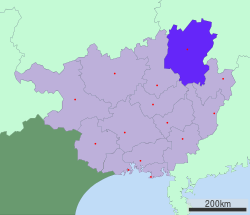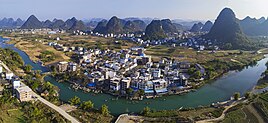This article needs additional citations for verification. (April 2011) |
Guilin
桂林市 • Gveilinz Si Kweilin | |
|---|---|
From left to right, top to bottom: View of Guilin city; Elephant Trunk Hill, Sun and Moon Pagodas; Longsheng Rice Terraces, Jingjiang Princes' Palace, Reed Flute Cave; Yangshuo scenery | |
 Location of Guilin City jurisdiction in Guangxi | |
| Coordinates (Guilin Central Square (桂林中心广场)): 25°16′30″N 110°17′46″E / 25.275°N 110.296°E | |
| Country | People's Republic of China |
| Autonomous region | Guangxi |
| Area | |
| • Prefecture-level city | 27,797 km2 (10,732 sq mi) |
| • Urban | 2,753 km2 (1,063 sq mi) |
| • Metro | 5,041 km2 (1,946 sq mi) |
| Elevation | 153 m (502 ft) |
| Population (2020 census)[1] | |
| • Prefecture-level city | 4,931,137 |
| • Density | 180/km2 (460/sq mi) |
| • Urban | 1,725,865 |
| • Urban density | 630/km2 (1,600/sq mi) |
| • Metro | 2,148,641 |
| • Metro density | 430/km2 (1,100/sq mi) |
| GDP[2] | |
| • Prefecture-level city | CN¥ 231.1 billion US$ 35.8 billion |
| • Per capita | CN¥ 46,767 US$ 7,249 |
| Time zone | UTC+8 (China Standard) |
| Postal code | 541XXX |
| Area code | 0773 |
| ISO 3166 code | CN-GX-03 |
| License plate prefixes | 桂C for Guilin's city proper, Yangshuo, and Lingui; all others 桂H |
| Website | www |
| Guilin | |||||||||||||||||||||||||||||
|---|---|---|---|---|---|---|---|---|---|---|---|---|---|---|---|---|---|---|---|---|---|---|---|---|---|---|---|---|---|
"Guìlín" in Chinese characters | |||||||||||||||||||||||||||||
| Chinese name | |||||||||||||||||||||||||||||
| Chinese | 桂林 | ||||||||||||||||||||||||||||
| Hanyu Pinyin | Guìlín | ||||||||||||||||||||||||||||
| Postal | Kweilin | ||||||||||||||||||||||||||||
| Literal meaning | "Sweet Osmanthus Forest" | ||||||||||||||||||||||||||||
| |||||||||||||||||||||||||||||
| Zhuang name | |||||||||||||||||||||||||||||
| Zhuang | Gveilinz | ||||||||||||||||||||||||||||
| 1957 orthography | Gveilinƨ | ||||||||||||||||||||||||||||
Guilin (Standard Zhuang: Gveilinz), formerly romanized as Kweilin, is a prefecture-level city in the northeast of China's Guangxi Zhuang Autonomous Region. It is situated on the west bank of the Li River and borders Hunan to the north. Its name means "forest of sweet osmanthus", owing to the large number of fragrant sweet osmanthus trees located in the region. The city has long been renowned for its scenery of karst topography.
Guilin is one of China's most popular tourist destinations,[3] and the epithet "By water, by mountains, most lovely, Guilin" (山水甲天下)[4] is often associated with the city. The State Council of China has designated Guilin a National Famous Historical and Cultural City, doing so in the first edition of the list.
- ^ "China: Guăngxī (Prefectures, Cities, Districts and Counties) - Population Statistics, Charts and Map".
- ^ "广西统计年鉴-2021", tjj.gxzf.gov.cn
- ^ Foster, Simon (2012). Frommer's China. John Wiley & Sons. pp. 612. ISBN 9781118223529.
- ^ “桂林山水甲天下”之英译. China Daily (in Chinese (China)). Retrieved 11 June 2019.







